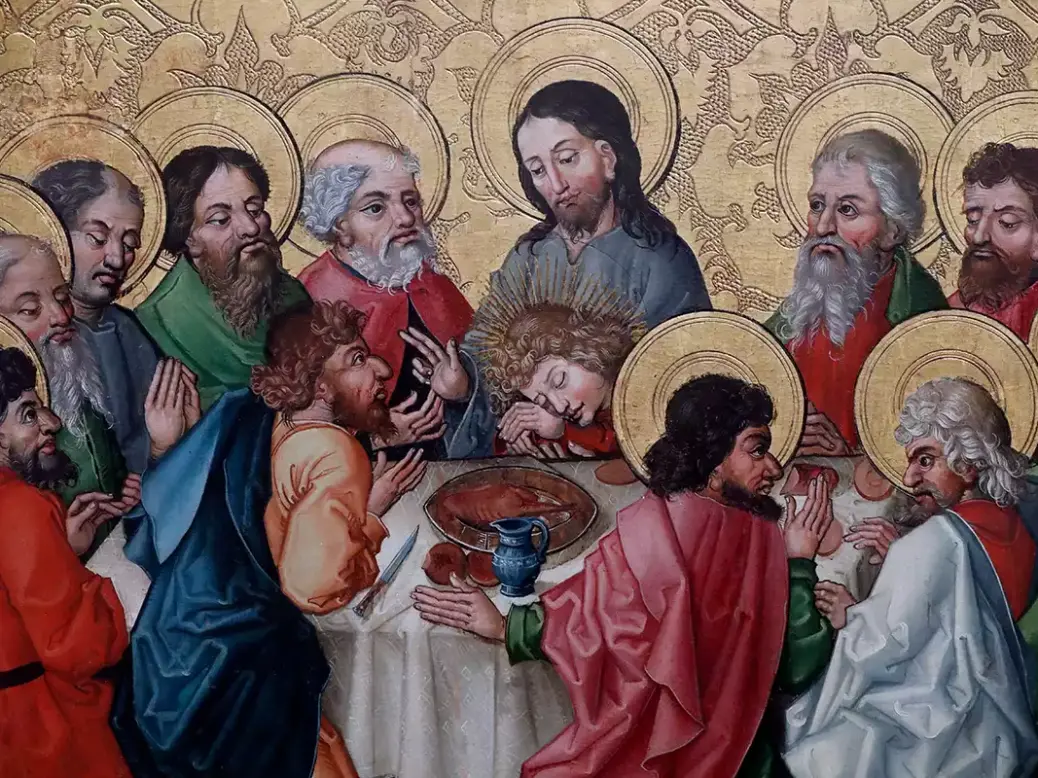
The color of red wine has suited it since antiquity to be the sustaining metaphor for blood. Not only does its color resemble vital fluid, but the juice itself and its method of extraction, could stand for the life-force of the grapevine. This is an image that occurs in Genesis (49:11), where it is said by Jacob at a family gathering of his male offspring that his son Judah washes his clothes, counter-intuitively enough, in wine, “the blood of grapes.” Vinous blood indeed is the only blood it is permissible to consume in Mosaic law, precisely because it is only metaphorically blood.
And yet its adjacency to the real thing is closer than mere visual homology and the structure of living organisms could suggest. In the song of Moses in the Deuteronomy (32:14), the gastronomic bounty Gods pours forth for his people includes not just sheep’s milk and kidney fat, but “the pure blood of grapes,” which, by a suggestive etymology, recalls its foaming character, perhaps from fermentation. The purity of it indicates not just its excellence, but the ideal state in which it is drunk unmixed, not even with water.
At the Last Supper, when the disciples are invited to share the cup of wine, Jesus explicitly announces that it stands for the blood he is about to shed. Medieval iconography would elaborate the eucharistic image into the torturous depiction of Christ in the winepress, his blood being crushed out of him for the general salvation, as juice is squeezed from the fruits of the vine to make a drink that restores vitality to those who consume it. The sacralization of wine is now complete.
In humoral medicine, wine was thought to be excellent for nourishing the blood and bringing warmth to the chilly constitution, on a prescriptive basis that even the simplest could understand. So close in nature was it to the principle of vivacity that William Harvey, the English physician credited with discovering the circulation of blood in the 1620s, draws an overt analogy between the two substances. Blood ceases to be blood when it has escaped the body because its life-force has ebbed out, just as wine becomes dead when, through oxidation, it loses its bouquet.
Notwithstanding that, exsanguinated blood passes through a borderline condition in which, for a while, it retains the vital element that had animated the body. In this condition, it could be—and widely was—used in agricultural practice for fertilizing vineyards. When poured around the vines’ roots, it nourished them and ensured the production of healthy, juice-laden fruit. The only bad kind of blood, according to patriarchal myth, was the menstrual variety, which is why it was particularly important to keep a woman in the first stage of her monthly cycle out of the vineyard. The mere proximity of such impurity could cause the vines to wither.
The redness of wine
The redness of wine made it an indispensable element in ritual sacrifice and in libations for the dead. From these contexts, it is clear why red wine has always been felt to be its superior manifestation. It disguised its spoilage better than white, just because it was richer in aroma and texture, and its habitually dark and viscous state made it all the more comparable to the blood that it symbolized. As such, it has frequently been pressed into literary service to denote the spilling of blood, nowhere more insistently than by Dickens in A Tale of Two Cities (1859), where the blood that flows from the guillotines in Revolutionary France is also the savage sacrament the crowds of spectators ingest.
In a contribution to a volume of essays on the cultural significations of blood in European history1, Frances Dolan makes the point that blood was a far more common sight in the past than it tends to be now. Public executions, bloodsports, domestic butchery, and the medical practice of bloodletting all played their part in accustoming people to the appearance and the smell of it. If most of us only encounter it when sloppy handling of the chopping knife leads to an accident in the kitchen, and are in the habit of looking the other way when the nurse takes a sample for a blood test, squeamishness has returned blood to the metaphorical realm from which it once emerged.
When “blood rises through the shoots” in Pablo Neruda’s “Ode to Wine,” we are back at the cultural habitus of the Book of Genesis, both authors too fastidious to allow that neither the sap nor the juice of the vine are red. Unlike the “purple feet” of its tinted counterpart, Neruda’s “day-colored” white wine has “topaz blood,” an ingenious oxymoron to cover its lack of sanguinity. If red wine symbolized blood, what did white wine represent? Urine was the likeliest answer, as evidenced by its more keenly promoting diuresis. There is nothing at all noble about that.
1 Blood Matters: Studies in European Literature and Thought, 1400-1700, eds. Bonnie Lander Johnson and Eleanor Decamp (Philadelphia PA: 2018), ch. 14.






